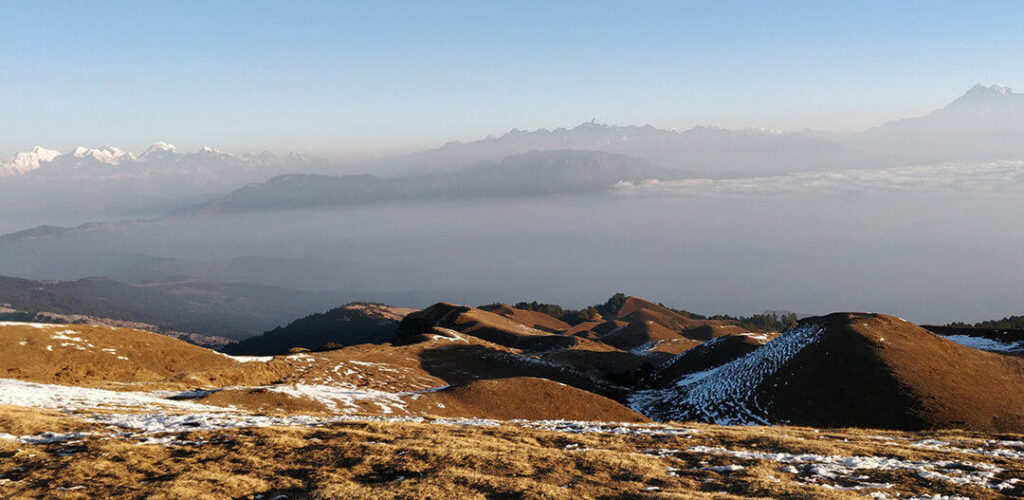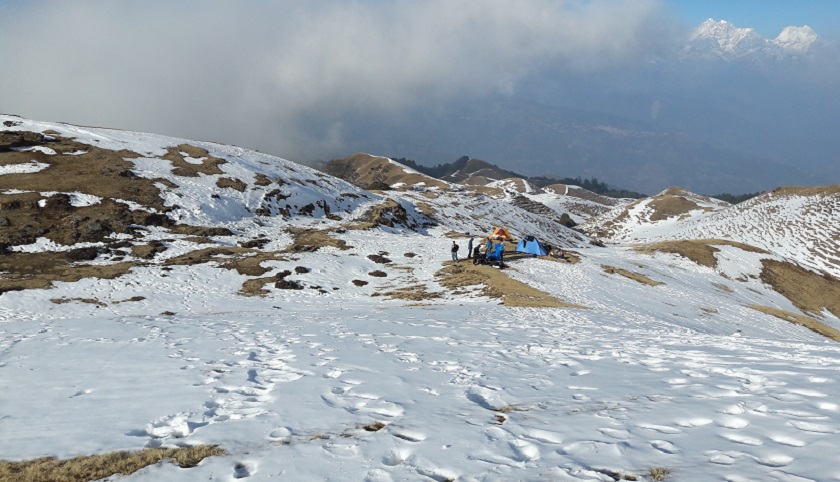The Nepali word ‘Shailung’ in the Tamang language means a hundred Shailung – Hundred Hillocks. It is also called as Shillong. Dozens of Shailung – Hundred Hillocks like piles of rice. Some high and some low. From every hillock, you can see the Snowy white Mountains. Dozens of mountains from Annapurna, Manaslu, Lamjung to Ganesh Himal, Langtang, Gaurishankar, Sagarmatha, and numbers of the mountain in the west.
Located in Shailung Rural Municipality on the border of Dolakha and Ramechhap, the highest hill in the Mahabharata, Shailung, is becoming a tourist destination of choice. Shillong, which has been under siege for some time, has recently been developing as a new attractive tourist destination for domestic and foreign tourists.
At an altitude of 3,300 meters, on a large plain with 100 different shapes, Shailung attracts tourists. The natural beauty of the snow-capped Shillong hills is being explored and the number of tourists enjoying the snow is also increasing.
With the snowfall in Shillong, which has 100 hillocks, tourists come to play adventure ski. The Nepal Mountain Academy has been bringing ski trainees for training in Shillong and a feasibility study has been done for ski operation and training in Shillong. The municipality is working for the development of infrastructure by formulating a master plan for the development of Shailung targeting tourists.
Table of Contents
Legend behind Shailung
Shailung has religious and cultural significance too. Locals say saints mediated in Shailung in the Satya Yuga. They say these 100 hillocks are the remains of the 100 saints.
How to reach Shillong / Shailung
Shillong/shailung can be reached directly from the federal capital Kathmandu via Mude and Charikot. It is possible to reach Kalapani, the base camp of Shillong, at a distance of 125 km from Kathmandu via Mudhe Bazaar, while it is possible to reach Shillong on foot from Kalapani. From the 3300-meter high Shailung hill, one can observe Shailung’s Hundred High lands, Gaurishankar Himal, Rolwaling mountain range as well as various scenic areas of Dolakha, Ramechhap, and Sindhupalchok. Hotels has already started operation in Kalapani, Dhungey. Jhor and Managaun already have homestay facilities.
Attraction
This attractive destination, which is home to over a hundred small hills, is popular among tourists to enjoy views of snowcapped mountains and breathtaking sceneries.
There are a dozen community forests in Shillong spread over ten square kilometers. There are more than 108 kinds of herbs. Also a variety of animals and birds. According to legend, the then Buddhist master kept a handful of rice. The same fist grew into a thump. On the hill is the Chaitya, the footsteps of Guru Padmasambhava and the temple of Shailungeshwar. Therefore, Shillong has become a common pilgrimage site for Hindus and Buddhists.
There are three big stones on the hill. Tiger, cow, and Crab shaped. Devotees worship them. Not only that, the flag is also inscribed with Buddhist mantras, which makes the hill colorful. Lighting a lamp in the Chaitya there is as good as burning in Kathmandu’s Swayambhunath and Bouddhanath. There are two big fairs on the hill. Before Janai Purnima, there is a crowd of Buddhists and on Bala Chartudashi, there is a crowd of Hindus. Buddhists chant mantras by lighting a lamp in memory of their father’s Memory. Hindus scatter satbij (seven types of seeds) and offer their late fathers. Similarly, Kushe Aunshi, Janai Purnima, and Lhosar also have fairs here.

Shailungeshwar Mahadev is sitting on a slope of the hill. There is a belief that if you visit Mahadev, your aspirations will be fulfilled. Near the temple are two caves called Godavari and Dharma. A fair is held in Godavari cave every 12 years. There is a milk tank. Sherpa says that milk falls from the tank only during the fair.
Shillong is one of the 100 major tourist destinations in Nepal declared by the government. It is not only a beautiful creation of nature but also a common pilgrimage of Hindus and Buddhists.
Best time to visit Shailung
Every season is best to visit this place. Spring season will let you experience lots of beautiful rhododendron forests. The rainy season might bring some difficulty to walk but the greenery in those meadows is heavenly for sure. The winter season will let you experience the clear views of mountains all around. Around February/March, the snow-covered hillocks would be certainly something to see.





